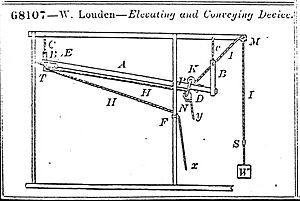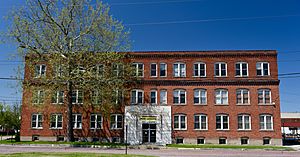Louden Machinery Company facts for kids
The Louden Machinery Company was an American company based in Fairfield, Iowa. It was started by William Louden. At first, the company made and sold a special machine called a hay carrier. William Louden invented this machine in 1867.
Later, the company grew and made many different types of farm equipment. In 1906, they even started an Architecture Department. This department designed more than 25,000 barns between 1906 and 1939. During World War I, Louden's overhead rail systems, which were used to carry things, began to be used in factories and for military needs. By the 1920s, a large part of the company's income came from these industrial uses.
Several places connected to the company are now listed on the National Register of Historic Places. These include the company's factory in Fairfield, some homes, and many barns in Iowa, Ohio, and Michigan that the company designed.
Contents
The Louden Machinery Company Story
How It All Began
The company was founded by William Louden (1841-1931). He was born in Pennsylvania and moved to Iowa as a baby. After studying, he became a teacher.
In 1867, William invented a hay carrier. This machine made it much easier to use two-story barns. It used a hay fork, but it attached it to an overhead rail. This rail allowed the hay fork and hay to be moved around inside a barn.
In 1868, he opened his first shop to make these hay carriers. Later that year, Louden moved his business to Fairfield. It was called Louden Manufacturing Works. Even though he faced money problems in the 1870s, he kept making hay carriers.
In 1887, William Louden and his wife, Mary Jane, officially formed the Louden Machinery Company. His younger brother, Robert B. "R.B." Louden (1857-1939), joined in 1889. R.B. became the company's president when it became a corporation in 1892. In the early 1890s, the company opened a factory in downtown Fairfield. This factory is still there today and is a historic site.
Growing Bigger
The company grew a lot in the 1890s and early 1900s. R.B. handled the business side, which left William free to invent new things. William added many products to the company's list. These included a flexible barn door hanger (1895) and machines to carry waste out of barns (1898). He also invented all-steel cow stalls (1907) and automatic watering bowls for cows (1912). Other inventions were an Easy Feeding Hog Trough (1914) and an industrial line of Overhead Carrying Equipment (1917).
Albert H. Neller, who was William Louden's "right-hand-man," also helped create many products. He was very important to the company's success in the 1910s and 1920s.
The company also expanded to new places. They opened branches in Canada (1900), Minneapolis (1903), Albany, New York (1912), and Chicago (1915). By 1915, the factory in Fairfield had 100 workers. The company also had another large factory in Guelph, Ontario. By 1920, the Louden Machinery Company had sales of $2.5 million.
The company kept adding more products in the 1920s and 1930s. These included barn cupolas (small towers on roofs), fans, pulleys, and power hoists. They also made concrete feeding troughs and a special garage door hanger. They even made playground equipment like slides, see-saws, and "whirl-arounds."
Designing Barns
In 1906, the company started its Architectural Department. This department offered a free "barn planning service." The company's architects designed barns to be more efficient. They also made sure the barns could use Louden equipment easily.
The Architecture Department designed barns for many places, including Homewood Farms. They also designed several barns that are now listed as historic places. The department designed special barns for dairy cows, horses, pigs, and chickens. They also planned entire farm layouts. The company reported that they had planned over 25,000 barns by 1939. The department also published catalogs of barn plans, including plans for round barns. The Architecture Department stopped working around 1947.
Industrial Uses for Louden Monorail
During World War I, Louden's overhead carrier system was changed for use in factories. For example, it was used to help make ammunition. By the 1920s, the company made a lot of money from using Louden Monorail systems in factories. Companies like Allis-Chalmers and General Motors used them to carry equipment.
The company also created a Louden Engineers division. This team designed special versions of the Louden Monorail for many different uses. These included factories, foundries (places where metal is cast), and even for handling clothing or movie lighting.
During World War II, the company produced more than ever before. This was because of the high demand for their overhead handling equipment. This included their improved "Super Track" monorail systems. Louden Monorail was used for important military projects. It helped move materials for making the first atomic bomb at Oak Ridge, Tennessee. It was also used in a B-29 bomber plane factory in Marietta, Georgia.
Later Years
William Louden passed away in 1931, and Robert B. Louden in 1939. William's son, Robert Bruce Louden, became president after Robert B. Louden died. He stayed president until his own death in 1952. Arthur Clare Louden, another son of William, was president from 1952 to 1953.
In 1956, the company was bought by Mechanical Handling Systems, Inc., from Detroit, Michigan. William's grandson, William L. Fry, was the company's president from 1956 to 1963. In 1965, Louden stopped making farm equipment. However, Louden's overhead handling equipment continued. It became part of the American Chain and Cable Company (ACCO). Today, Acco-Louden still makes overhead monorail conveying equipment.
Historic Places
Many buildings and structures connected to the Louden Machinery Company and the Louden family are listed on the National Register of Historic Places. This means they are important historical sites.
Places Connected to Louden Machinery Company
Some sites fully or partly connected to the Louden Machinery Company include:
- Fred and Rosa Fulton Barn, in Selma, Iowa.
- Granot Loma, a farm complex in Marquette, Michigan. Louden designs were used here.
- Louden Machinery Company, also known as the Broadway Building, in Fairfield, Iowa. This was the main factory.
- Louden Monorail System in the Auto Repair Shop, in Fairfield, Iowa.
- Louden Whirl-Around (1925), a piece of playground equipment in Fairfield, Iowa.
- R. B. and Lizzie L. Louden House (1871), in Fairfield, Iowa.
- R.R. and Antoinette Louden House (1925), in Fairfield, Iowa. This home was designed by C. Eugene Fleming from the Louden Architecture Department.
- August and Vera Luedtke Barn, near Fairfield, Iowa. Designed by the Louden Architecture Department.
- McCafferty Run Farmstead, in Chillicothe, Ohio. The dairy barn here is a Louden design.
- Midway Stock Farm Barn, north of Keosauqua, Iowa. This barn has Louden equipment.
- Hancock Shaker Village, in Pittsfield, MA. A dairy section was added to a barn complex in 1939 using a Louden plan.
Family Homes
Some homes of the Louden family members are also listed:
- Arthur C. and Maud Louden House, in Fairfield, Iowa.
- R. Bruce and May W. Louden House, in Fairfield, Iowa.
- William and Mary Jane Louden House (1897), in Fairfield, Iowa. This was the home of the company founder, William Louden.






